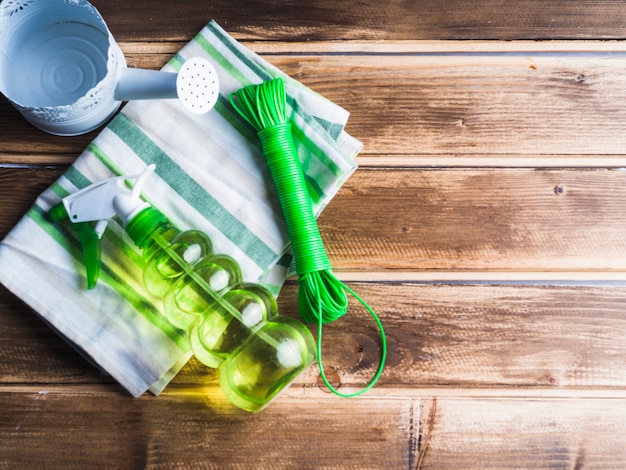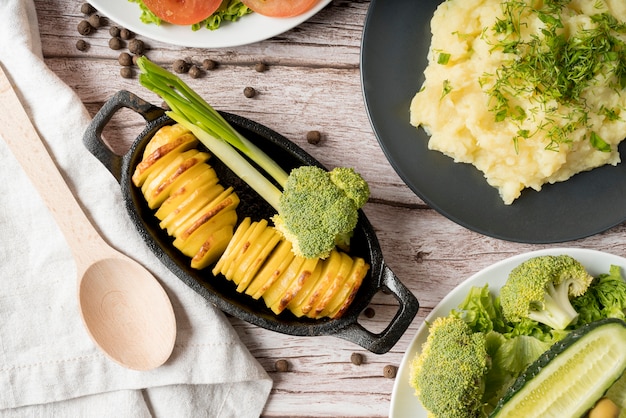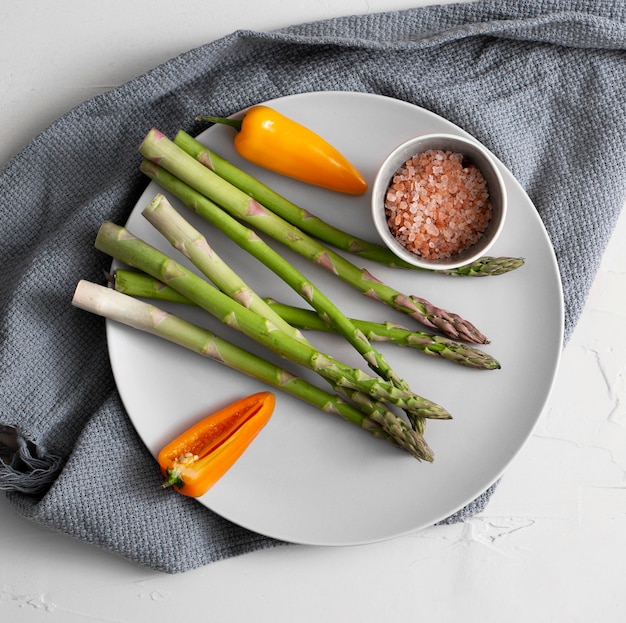Springtime is asparagus season, and for me, that's a reason to celebrate! There's just something about its vibrant green colour, crisp snap, and delicate flavour that gets me excited. It's a vegetable that I can't resist, especially when it's fresh from the market. While you can roast, grill, or even bake asparagus, I find that cooking it on the stovetop really brings out its best qualities. The result is a dish that's both quick and easy to make, yet incredibly flavorful and satisfying.
You don't need to be a culinary whiz to create a delicious asparagus dish. In fact, I've learned that sometimes the simplest recipes are the most rewarding. Whether you're looking for a quick side dish for dinner, a light lunch, or a sophisticated appetizer, stovetop asparagus is always a winner. So grab your trusty pan and let's dive into the wonderful world of asparagus cooked on the stove.
(Part 1) The Basics: Choosing and preparing asparagus

The First Step: Choosing the Right Asparagus
Like any good chef, you've got to start with the right ingredients. So, how do you pick the perfect asparagus? First off, I always look for spears that are firm and crisp, with tightly closed tips. This is a sign that they're fresh and full of flavour. Avoid any that are limp or have wilted tips – those are signs that the asparagus is past its prime and might be a bit tough to eat.
Next, take a look at the colour. Bright green asparagus is usually the most flavorful, but you might find some purple asparagus too. Purple asparagus is a bit more mature, so it might be slightly tougher but still delicious. It's all about personal preference! Just make sure it's not too woody or fibrous, which can make it unpleasant to eat. Remember, a good asparagus should have a smooth, uniform appearance with no signs of damage or bruising.
Preparing Your Asparagus: It's All in the Trimming
Once you've got your asparagus, it's time to get down to business with the trimming. It's an essential step because those tough, woody ends are not only unpleasant to chew but can also ruin the overall flavour of your dish. You might be thinking, "Is there a secret trick?" And there is!
The easiest way to determine where to trim is to snap the asparagus. Gently bend the bottom of the spear. It'll naturally snap at the point where the woody part starts. It's a little trick I learned from my grandma, and it's worked wonders for me. If you're not sure, you can always trim about an inch off the bottom. It's better to be safe than sorry.
Now you've got some beautifully trimmed asparagus ready to go! You can either wash them quickly or leave them as they are. I usually give them a quick rinse, just to get rid of any dirt or grit, but it's completely up to you. And that's it! Your asparagus is now ready to be cooked into a delicious masterpiece.
(Part 2) Simple Stovetop Asparagus: The Classic Methods

The pan-fried asparagus: A Quick and Easy Side Dish
This is my go-to asparagus recipe. It's so simple, yet incredibly flavourful. It's the perfect side dish for any meal, whether it's grilled fish, roasted chicken, or even a hearty pasta dish.
- Start by heating a drizzle of olive oil in a large skillet over medium-high heat. I usually use a good quality extra virgin olive oil, as it adds a lovely depth of flavour to the asparagus.
- Add your asparagus spears, making sure they’re all in a single layer. You don't want to overcrowd the pan or they won't cook evenly. The asparagus should sizzle gently in the oil, not steam.
- Season with salt and pepper to taste, and let it all sizzle for about 3-5 minutes, turning the spears halfway through. I like to give the asparagus a good toss every now and then to ensure that it cooks evenly.
- For extra flavour, you can add a squeeze of lemon juice or a sprinkle of red pepper flakes at the end. A squeeze of lemon brightens the dish beautifully, while a pinch of red pepper flakes adds a subtle kick of spice.
The result is perfectly tender asparagus with a slight char, full of flavour. The asparagus should be tender but still retain a bit of its crispness. It's so good, you might just want to eat it straight from the pan. And if you do, I won't judge!
The steamed asparagus: Simple and Healthy
Steaming asparagus is another super quick and easy option. It's a fantastic way to retain its vibrant green colour and delicate flavour.
- Fill a saucepan with about an inch of water and bring it to a boil. I usually add a pinch of salt to the water, as it helps to season the asparagus.
- Place a steamer basket inside the pan and add your asparagus spears. Make sure they aren't overcrowded. The asparagus should have enough space to steam evenly without getting soggy.
- Cover the pan and steam for about 3-5 minutes, or until the asparagus is tender but still slightly crisp. You can check for doneness by piercing the asparagus with a fork or a knife.
- You can also add a few slices of lemon or a sprig of fresh herbs to the steamer basket for extra flavour. Lemon and herbs like thyme or rosemary go beautifully with asparagus.
Steamed asparagus is incredibly versatile. It's perfect for a light lunch or a side dish, and it can be easily dressed up with a drizzle of olive oil, a squeeze of lemon, or a sprinkle of parmesan cheese.
(Part 3) Asparagus on the Stove: Elevating the Classics

The Asparagus with Garlic and Lemon: A Burst of Flavour
This recipe is all about bringing out the best of both worlds: the delicate flavour of asparagus and the tangy goodness of garlic and lemon. It's a simple dish that packs a punch of flavour and is sure to impress.
- Start by heating a generous drizzle of olive oil in a large skillet over medium heat.
- Add minced garlic and let it sizzle for about 30 seconds, until fragrant. I like to use fresh garlic for the best flavour, but you can also use pre-minced garlic if you're in a hurry.
- Add the asparagus spears and cook for about 4-6 minutes, turning them halfway through. You want the asparagus to be tender-crisp, with a slight char on the edges.
- Just before serving, squeeze in the juice of half a lemon, a pinch of salt, and a grind of black pepper. The lemon juice adds a bright, tangy flavour, while the salt and pepper enhance the natural flavours of the asparagus.
The combination of garlic and lemon is a classic for a reason. It enhances the asparagus's natural flavours and creates a beautiful, bright dish.
The asparagus with balsamic glaze: A Touch of Sweetness
This recipe takes the classic pan-fried asparagus to the next level with a simple but delicious balsamic glaze. It adds a touch of sweetness and acidity that balances out the asparagus perfectly.
- Start by pan-frying the asparagus as described in the first recipe.
- Once the asparagus is cooked, remove it from the pan and set aside.
- Add a tablespoon of balsamic vinegar to the pan and bring it to a simmer.
- Cook until the vinegar has reduced by half and thickened slightly. This will take about 2-3 minutes, and you'll know it's ready when it coats the back of a spoon.
- Pour the glaze over the asparagus and serve immediately. The glaze will be hot, so be careful when pouring it over the asparagus.
The balsamic glaze adds a touch of sophistication and depth to the dish. It’s a perfect recipe for a special occasion or a fancy dinner party.
(Part 4) Exploring New Flavours: Beyond the Basics
The Asparagus with Chili Flakes: A Spicy Kick
If you love a bit of heat, this recipe is for you. The addition of chili flakes adds a touch of spice that complements the asparagus beautifully.
- Start by pan-frying your asparagus as described in the first recipe.
- Just before serving, add a pinch of red pepper flakes to the pan, and let it sizzle for a few seconds. Use a small amount of chili flakes, as a little goes a long way. You can always add more if you want a spicier kick.
- Serve immediately.
The chili flakes add a bit of a kick to the dish, but don’t worry, they aren’t overpowering. The spiciness is subtle, but it adds a nice depth of flavour to the dish.
The Asparagus with Toasted Almonds: A Crunchy Delight
This recipe is all about adding texture and flavour to your asparagus. The toasted almonds add a nutty crunch that complements the asparagus perfectly.
- Toast your almonds in a dry skillet over medium heat for about 2-3 minutes, or until golden brown. Keep a close eye on the almonds, as they can burn easily.
- While the almonds are toasting, pan-fry your asparagus as described in the first recipe.
- Once the asparagus is cooked, remove it from the pan and toss it with the toasted almonds. You can also add a sprinkle of chopped fresh herbs for extra flavour.
The crunch of the almonds and the delicate flavour of asparagus make a delicious combination. It's a great way to add a bit of texture and a nutty flavour to your asparagus dish.
(Part 5) Asparagus side dishes: Perfect for Any Meal
asparagus salad with Dijon Vinaigrette: A Light and Refreshing Side
This salad is the perfect way to enjoy asparagus during the warmer months. It’s light and refreshing, and the Dijon vinaigrette adds a tangy kick.
- Steam or pan-fry your asparagus as you prefer. I find that steaming asparagus is a great way to retain its vibrant green colour and delicate flavour.
- While the asparagus is cooking, whisk together a Dijon vinaigrette using olive oil, Dijon mustard, lemon juice, salt, and pepper. You can adjust the amount of each ingredient to your liking. For a bolder vinaigrette, use more Dijon mustard and lemon juice. For a milder vinaigrette, use less mustard and lemon juice.
- Toss the cooked asparagus with the vinaigrette and serve. You can also add other ingredients to the salad, such as cherry tomatoes, red onion, or fresh herbs, to add more flavour and texture.
You can also add other ingredients to the salad, such as cherry tomatoes, red onion, or fresh herbs.
Creamy asparagus soup: A Comforting and Delicious Option
This soup is perfect for a chilly evening. It’s creamy, comforting, and bursting with flavour. The secret is to use a good quality vegetable broth for the base.
- Steam or pan-fry your asparagus, then blend it with a potato until smooth. You can also add a little bit of cream or milk to the soup for extra creaminess.
- Add vegetable broth and simmer for about 15 minutes, until the soup has thickened. You can adjust the consistency of the soup by adding more or less broth.
- Season with salt and pepper to taste, and garnish with chopped fresh herbs before serving. I like to use fresh dill or parsley, as they complement the asparagus beautifully.
You can also add a dollop of cream or a swirl of pesto for extra flavour.
(Part 6) Asparagus Appetizers: Impress Your Guests
Asparagus and Goat Cheese Tartlets: A Fancy Finger Food
These tartlets are perfect for a cocktail party or a special occasion. The combination of asparagus and goat cheese is a classic, and the tartlets add a touch of elegance.
- Prepare your favourite pastry dough and blind bake it in tartlet tins. You can use store-bought pastry dough or make your own.
- Steam or pan-fry your asparagus until tender.
- Mix the cooked asparagus with crumbled goat cheese, fresh herbs, and a squeeze of lemon juice. I like to use a mild goat cheese, but you can use a stronger goat cheese if you prefer.
- Spoon the mixture into the tartlet shells and bake for a few minutes until the filling is heated through. The tartlets should be heated through but not overly browned.
You can also add a sprinkle of toasted walnuts or pecans for extra crunch and flavour.
Asparagus and smoked salmon Crostini: A Savoury Delight
These crostini are a simple yet elegant appetizer that’s sure to impress your guests. The combination of smoked salmon and asparagus is a classic for a reason.
- Toast some slices of baguette or sourdough bread. You can toast the bread in the oven or under a broiler.
- Steam or pan-fry your asparagus until tender.
- Spread the toasted bread with cream cheese or ricotta cheese. You can also use a flavoured cream cheese, such as chive or onion, for extra flavour.
- Top with smoked salmon, cooked asparagus, and a sprinkle of fresh dill. You can also add a squeeze of lemon juice or a drizzle of balsamic glaze for extra flavour.
You can also add a squeeze of lemon juice or a drizzle of balsamic glaze for extra flavour.
(Part 7) Asparagus in Your Garden: A Homegrown Treat
Growing your own asparagus is a rewarding experience. It’s a relatively easy vegetable to grow, and it’s a great addition to any vegetable garden.
Planting Your Asparagus: A Springtime Ritual
Asparagus crowns are the starting point for growing your own. It’s best to plant them in the spring, when the soil has warmed up.
- Choose a sunny spot in your garden with well-drained soil. Asparagus prefers full sun, but it can tolerate some partial shade.
- Dig a trench about 12 inches deep and 18 inches wide. The trench should be deep enough to accommodate the asparagus crowns and allow for proper root development.
- Amend the soil with compost or manure. This will help to improve the drainage and fertility of the soil.
- Place the asparagus crowns in the trench, about 18 inches apart. The crowns should be placed so that the roots are facing down and the buds are facing up.
- Cover the crowns with soil, leaving about 2 inches of soil above the crowns. Water the soil well after planting.
Caring for Your Asparagus: A Simple Routine
Once your asparagus is planted, it’s important to keep it watered and fertilized.
- Water regularly, especially during dry periods. Asparagus needs consistent moisture to thrive.
- Fertilize in the spring with a balanced fertilizer. You can use a granular fertilizer or a liquid fertilizer.
- Harvest the asparagus spears when they are about 6-8 inches tall. You should start harvesting asparagus after about two years, and you should be able to enjoy fresh, homegrown asparagus for many years to come.
- Once you’ve harvested your asparagus, it’s important to let the plants grow for the rest of the season, so they can store energy for the following year. This will help to ensure that you have a bountiful harvest the following year.
You can start harvesting your asparagus after about two years, and you should be able to enjoy fresh, homegrown asparagus for many years to come.
(Part 8) FAQs: Your Asparagus Questions Answered
- How long does asparagus last in the refrigerator?
- How can I tell if asparagus is bad?
- What can I do with leftover asparagus?
- Can I freeze asparagus?
- How do I prevent asparagus from getting tough?
- Asparagus can last for about 3-5 days in the refrigerator. Keep it in a plastic bag or wrapped in a paper towel.
- Asparagus that is bad will have a wilted appearance, a yellow or brown colour, and a slimy texture. It might also have a strong, unpleasant odour.
- Leftover asparagus can be added to soups, stews, or pasta dishes. You can also use it to make a frittata or an omelette.
- You can freeze asparagus, but it’s best to blanch it first. Blanching involves boiling the asparagus for a short time, then plunging it into ice water. This helps to preserve its colour and texture.
- To prevent asparagus from getting tough, don’t overcook it. It should be tender but still slightly crisp. You can also avoid overcrowding the pan when cooking asparagus, as this can lead to uneven cooking.
There you have it, asparagus on the stove: a simple, versatile vegetable that can be enjoyed in countless ways. Whether you’re looking for a quick and easy side dish, a sophisticated appetizer, or a comforting soup, there’s an asparagus recipe out there for everyone.
So next time you’re at the market, pick up some asparagus and give one of these recipes a try. You might just discover your new favourite spring vegetable!
Everyone is watching

Corn on the Cob: The Ultimate Guide to Perfectly Cooked Ears
Healthy MealsAh, corn on the cob. Just the name evokes images of sunny days, barbecues, and that sweet, juicy flavour that ...

Scallops: The Ultimate Guide to Perfect Cooking
Healthy MealsAh, scallops. Those delicate, sweet, and utterly delicious morsels of the sea. They hold a special place in my...

Spaghetti Squash: The Ultimate Guide to Cooking and Serving
Healthy MealsRemember that time you saw spaghetti squash at the supermarket, looking all bumpy and strange, and thought, "W...

Salmon Cooking Times: Perfect Guide for Every Recipe
Healthy MealsLet me tell you, cooking salmon is an art form. It's all about getting that perfect balance: juicy and tender,...

Ham Cooking Time: How Long to Bake, Smoke, or Boil a Delicious Ham
Healthy MealsAh, ham. It's a classic, isn't it? A real crowd-pleaser, especially around holidays. And when done right, it'...
